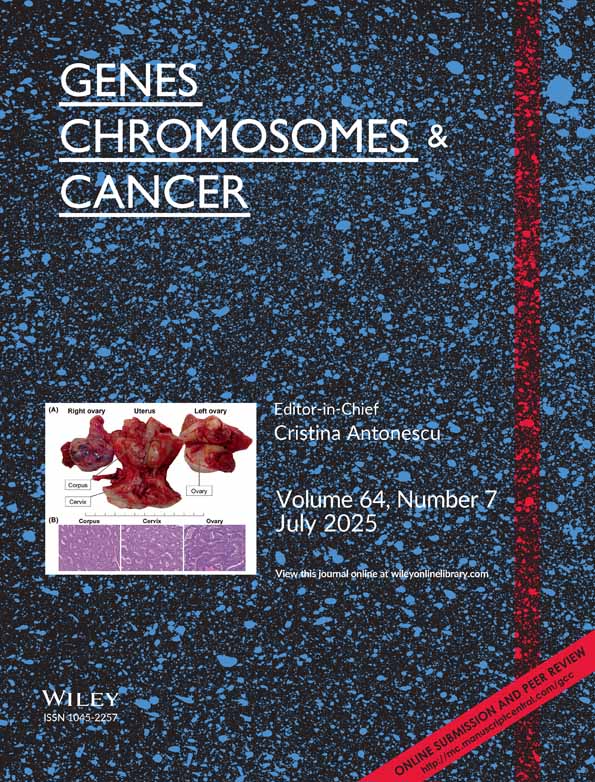MLL is involved in a t(2;11)(p21;q23) in a patient with acute myeloblastic leukemia
S. Reshmi
University of Chicago Medical Center, Section of Hematology/Oncology, Chicago, Illinois
Search for more papers by this authorCorresponding Author
J.D. Rowley
University of Chicago Medical Center, Section of Hematology/Oncology, Chicago, Illinois
University of Chicago Medical Center, Section of Hematology/Oncology, 5841 S. Maryland Ave., MC 2115, Chicago, IL 60637–1470.Search for more papers by this authorS. Reshmi
University of Chicago Medical Center, Section of Hematology/Oncology, Chicago, Illinois
Search for more papers by this authorCorresponding Author
J.D. Rowley
University of Chicago Medical Center, Section of Hematology/Oncology, Chicago, Illinois
University of Chicago Medical Center, Section of Hematology/Oncology, 5841 S. Maryland Ave., MC 2115, Chicago, IL 60637–1470.Search for more papers by this authorAbstract
We describe a patient with acute myeloblastic leukemia (AML-M0) whose cells had a t(2;11)(p21;q23). Fluorescence in situ hybridization analysis with a probe for MLL showed that it was split, hybridizing to both the derivative 2 and 11 chromosomes. Nineteen other patients with 2p;11q translocations have been described; breakpoints in 14 of these are the same as in the case we describe. The phenotype of these patients is quite variable, with 14 patients having myelodysplastic syndrome which evolved to AML in six. Four patients had AML and two had acute lymphoblastic leukemia. MLL status has been studied in two other patients; one had MLL rearranged and one did not. Genes Chromosomes Cancer 24:151–155, 1999. © 1999 Wiley-Liss, Inc.
REFERENCES
- Bernard OA, Berger R. 1995. Molecular basis of 11q23 rearrangements in hematopoietic malignant proliferations. Genes Chromosomes Cancer 13: 75–85. Medline
- Boultwood J, Fidler C, Levis S, MacCarty A, Sheridan H, Kelly S, Oscier D, Buckle VJ, Wainscoat JS. 1991. Loss of both CSF1R (FMS) alleles in patients with myelodysplasia and a chromosome 5 deletion. Proc Natl Acad Sci USA 88: 6176–6180. Medline
- Casey G, Rudzki Z, Roberts M, Hutchins C, Juttner C. 1993. N-RAS mutation in acute myeloid leukemia: Incidence, prognostic significance and value as a marker of minimal residual disease. Pathology 25: 57–62. Medline
- de la Chapelle A, Knuutila S, Elonen E. 1986. Translocation (2;11)(p21;q23) in acute nonlymphocytic leukemia: A non-random association. Scand J Haematol 45: 91–97.
- Feder M, Finan J, Besa E, Nowell P. 1985. A 2p11q chromosome translocation in dysmyelopoietic preleukemia. Cancer Genet Cytogenet 15: 143–150. Medline
- Finke J, Kunzmann R, Lange W. 1994. Detection of chromosome 11q23 involving translocations by pulsed field gel electrophoresis. Ann Hematol 68: 133–138. Medline
- Fleischmann EW, Prigogina EL, Iljinskaja GW, Konstantinova LN, Puchkova GP, Volkova MA, Frenkel MA. 1983. Chromosomal rearrangements with a common breakpoint at 6p23 in five cases of myeloid leukemia. Hum Genet 64: 254–256. Medline
- Harrison CJ, Cuneo A, Clark R, Johansson B, Lafage-Pochitaloff M, Mugneret F, Moorman AV, Secker-Walker LM, on behalf of the European 11q23 Workshop participant. 1998. Ten novel 11q23 chromosomal partner sites. Leukemia 12: 811–822. Medline
- Hillion J, Le Coniat M, Jonveaux P, Berger R, Bernard OA. 1997. AF6q21, a novel partner of the MLL gene in t(6;11)(q21;q23), defines a forkhead transcriptional factor subfamily. Blood 90: 3714–3719. Medline
- Ida K, Kitabayashi I, Taki T, Taniwaki M, Noro K, Yamamoto M, Ohki M, Hayashi Y. 1997. Adenoviral E1A-associated protein p300 is involved in acute myeloid leukemia with t(11;22)(q23;q13). Blood 90: 4699–4704. Medline
-
Kardon N,
Shulman P,
Deggnan T,
Budman DR,
Davis J,
Vicinguerra V.
1982.
Cytogenetic findings in dysmyelopoietic syndrome.
Cancer
50: 2834–2838.
Medline
10.1002/1097-0142(19821215)50:12<2834::AID-CNCR2820501224>3.0.CO;2-H CAS PubMed Web of Science® Google Scholar
- Mecucci C, Van Orshoven A, Vermaelen K, Michaux JL, Tricot G, Louwagie A, Delannoy A, Van den Berghe H. 1988. 11q-Chromosome is associated with abnormal iron stores in myelodysplastic syndromes. Cancer Genet Cytogenet 27: 39–44.
- Musilova J, Michalova K. 1988. Chromosome study of 85 patients with myelodysplastic syndrome. Cancer Genet Cytogenet 33: 39–50. Medline
- Parlier V, van Melle G, Beris PH, Schmidt PM, Tobler A, Haller E, Jotterand Bellomo M. 1994. Hematologic, clinical and cytogenetic analysis in 109 patients with primary myelodysplastic syndrome: Prognostic significance of morphology and chromosome findings. Cancer Genet Cytogenet 78: 219–231. Medline
- Prigogina EL, Fleischman EW, Puchkova GP, Mayakova SA, Frenkel MA. 1986. Chromosomes in acute nonlymphocytic leukemia. Hum Genet 73: 137–146. Medline
- Rowley JD. 1993. Rearrangements involving chromosome band 11q23 in acute leukemia. In: TH Rabbitts, editor. Seminars in Cancer Biology. 4: 377–385. London: Academic Press.
- Rowley JD, Reshmi S, Sobulo O, Musvee T, Anastasi J, Raimondi S, Schneider NR, Barredo JC, Cantu ES, Schlegelberger B, Behm F, Doggett NA, Borrow J, Zeleznik-Le N. 1997. All patients with the t(11;16)(q23;p13.3) that involves MLL and CBP have treatment-related hematologic disorders. Blood 90: 535–541. Medline
-
Satake N,
Ishida Y,
Otoh Y,
Hinohara S,
Kobayashi H,
Sakashita A,
Maseki N,
Kaneko Y.
1997.
Novel MLL-CBP fusion transcript in therapy-related chronic myelomonocytic leukemia with a t(11;16)(q23;p13) chromosome translocation.
Genes Chromosomes Cancer
20: 60–63.
Medline
10.1002/(SICI)1098-2264(199709)20:1<60::AID-GCC9>3.0.CO;2-7 CAS PubMed Web of Science® Google Scholar
- Taki T, Sako M, Tsuchida M, Hayashi Y. 1997. The t(11;16)(q23;p13) translocation in myelodysplastic syndrome fuses the MLL gene to the CBP gene. Blood 89: 3945–3950. Medline
- Testoni N, Zaccaria A, Celso B, Tassinari A, Rosti G, Tura S. 1989. 5q- and t(2;11) in a patient with M2 acute non-lymphocytic leukemia: Case report. Hematologica 74: 595–599.
- Theossoglou CH, Scalise A, Thou K, Silverman L, Perdahl-Wallace E, Naifeld V. 1992. Del(5q) in acute lymphoblastic leukemia with biphenotypic and early progenitor phenotype. Cancer Genet Cytogenet 63: 89–94. Medline
- Thirman MJ, Gill HJ, Burnett RC, Mbangkollo D, McCabe NR, Kobayashi H, Ziemin-van der Poel S, Kaneko Y, Morgan R, Sandberg AA, Chaganti RSK, Larson RA, Le Beau MM, Diaz MO, Rowley JD. 1993. Rearrangement of the MLL gene in acute lymphoblastic and acute myeloid leukemias with 11q23 chromosomal translocations. New Engl J Med 329: 909–914. Medline




